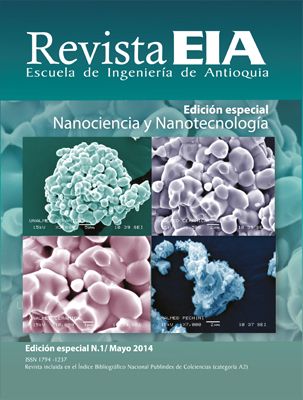Redistribución de la carga en anillos cuánticos tipo II con excitón capturado bajo campo magnético
Redistribución de la carga en anillos cuánticos tipo II con excitón capturado bajo campo magnético


This work is licensed under a Creative Commons Attribution-NonCommercial-NoDerivatives 4.0 International License.
Copyright statement
The authors exclusively assign to the Universidad EIA, with the power to assign to third parties, all the exploitation rights that derive from the works that are accepted for publication in the Revista EIA, as well as in any product derived from it and, in in particular, those of reproduction, distribution, public communication (including interactive making available) and transformation (including adaptation, modification and, where appropriate, translation), for all types of exploitation (by way of example and not limitation : in paper, electronic, online, computer or audiovisual format, as well as in any other format, even for promotional or advertising purposes and / or for the production of derivative products), for a worldwide territorial scope and for the entire duration of the rights provided for in the current published text of the Intellectual Property Law. This assignment will be made by the authors without the right to any type of remuneration or compensation.
Consequently, the author may not publish or disseminate the works that are selected for publication in the Revista EIA, neither totally nor partially, nor authorize their publication to third parties, without the prior express authorization, requested and granted in writing, from the Univeridad EIA.
Show authors biography
En este artículo se presenta un método sencillo para calcular las energías y las funciones de onda correspondientes a los estados más bajos de un excitón capturado por un anillo cuántico tipo II de InP, donde el electrón está confinado dentro del anillo y el hueco se localiza fuera de este. En este trabajo se muestra que la ecuación de Schrödinger para las dos partículas es completamente separable en el límite adiabático, es decir, cuando el ancho del anillo es mucho menor que el radio medio del anillo y la masa efectiva del hueco es mucho mayor que la del electrón. Las ecuaciones diferenciales unidimensionales separadas correspondientes a los movimientos del electrón y del hueco en dirección radial han sido solucionadas mediante el método de barrido trigonométrico, mientras que la solución a las ecuaciones para el movimiento rotacional ha sido hallada por medio de una expansión en series de Fourier. Se presentan resultados de los cálculos de algunos de los niveles de energía más bajos en función del ancho y radio del anillo, y de la intensidad de un campo magnético externo aplicado a lo largo del eje de simetría. Las curvas para los niveles de energía respecto a la intensidad del campo magnético presentan cruces que cambian el ordenamiento de los niveles y también muestran oscilaciones en la energía del estado base.
Abstract: We present a simple method for calculating the energies and wave functions corresponding to the low-lying states of exciton captured by type II InP quantum ring, where the electron is confined in the dot and the hole sits outside. We show that the two-particle Schrödinger equation is completely separable in the adiabatic limit, when the ring’s width is much smaller than the ring’s centreline radius and the hole effective mass is much larger than one of the electron. The separated one-dimensional differential equations for the electron and the hole motions in the radial direction we solve by using the trigonometric sweep method, while the solutions of the equations for rotational motions we find by means of the Fourier series expansion technique. We present result of calculation of some low-lying energy levels as functions of the ring’s width and radius and the strength of the external magnetic field applied along the symmetry axis. The curves of the dependencies of the low-lying energies on the magnetic field strength present crossovers change of the level ordering and oscillation of the ground state energy.
Article visits 254 | PDF visits 156
